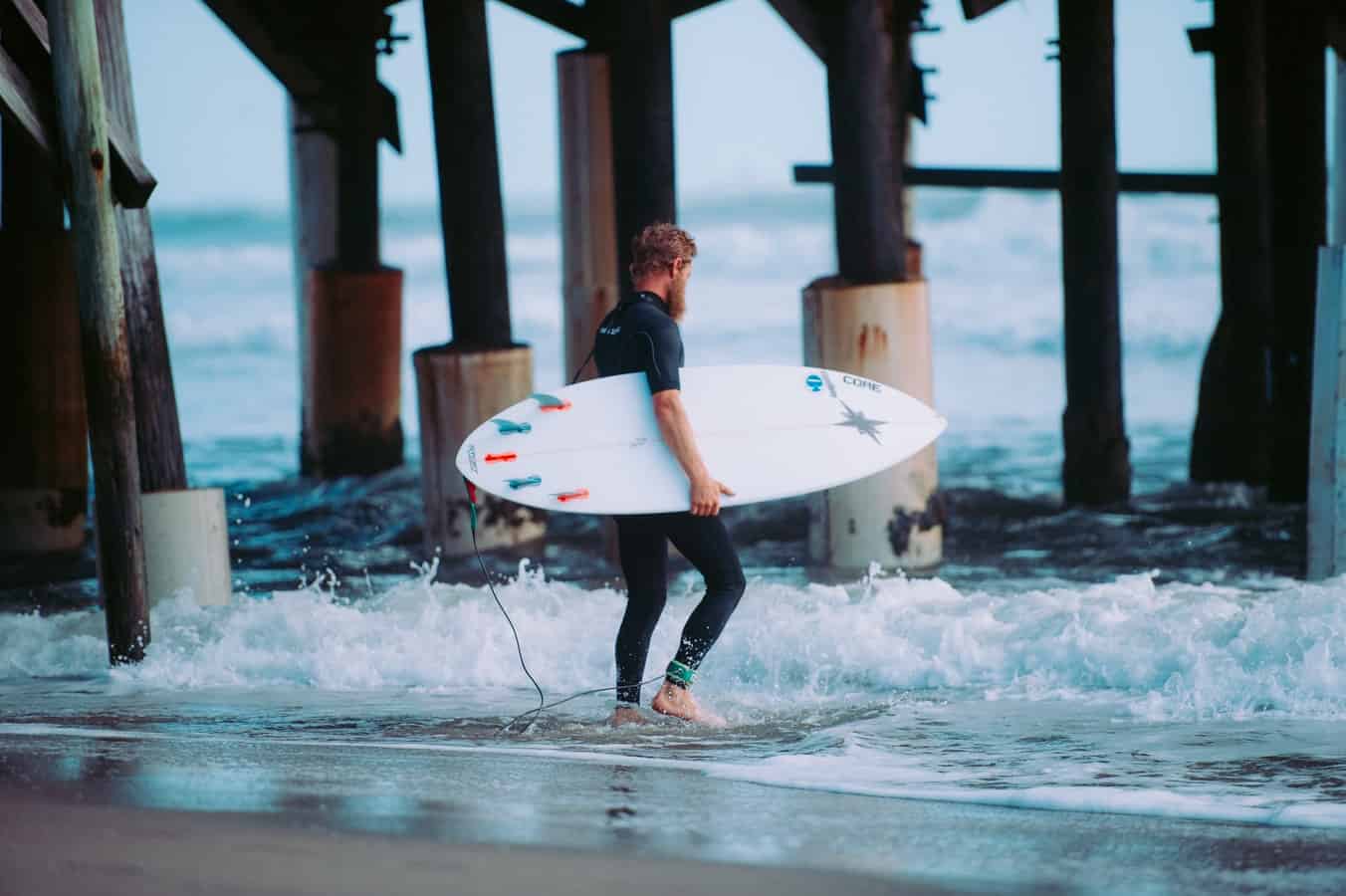Once upon a time, no one wore a surf leash. Surfers all went out on the waves leashless. Rolling and tumbling in the waves, chasing after the big, heavy boards of the time.
Then in 1971, out of Santa Cruz, came the first surfboard leash. A crude cord of surgical tubing attached to a board and foot.
Credited as being invented by Pat O’Neill, son of Jack O’Neill, owner of the surf company of the same name, this cord effectively changed the surf scene.
Once called “kook cords”, these leashes are now an essential piece of gear for any surfer.
Eliminating the need to swim long distances after your board, leashes also keep surfboards from running astray and hitting other surfers.
But for the newly initiated, you might wonder the very basic question, how do you properly wear one?
The surfboard leash connects from the leash plug on your board to the ankle by velcro. The leash is then worn on the ankle of the foot closest to the back or tail of your board.
A leash is a cord attached to your board that is then attached to the ankle. The proper way to wear a leash, is by securing it to the foot you place at the tail, or back end, of the board.
So, which foot should your surfboard leash go on? For regular footed surfers this is the right foot. For goofy, it’s the left foot.
Leashes first came about in the early 70’s and were made of surgical tubing. Today’s leashes are usually made of urethane, making them more stretchy and less likely to snap than its predecessors.
Not every surfer always wears a leash, but they’re essential for beginning and intermediate skill levels.
Using a leash prevents a board from running away causing injury to another surfer. They also prevent having to swim to your board after a wipe out, something that happens often for beginner surfers.
In general leashes are a beneficial tool out on the water, promoting better safety for all riders.
Parts of the Leash
A typical surf leash is made up of 5 parts. From bottom to top a surf leash consists of the ankle strap, cord, swivel, rail saver and string.
The ankle strap is typically made of velcro and secures you to the leash.
Cords are like the meat of the leash and are made of urethane. They’re typically about as long as your surfboard but this varies depending on your board, preference and skill.
Swivels lie between the cord and the rail saver and allow your leash movement. They act as a joint and help keep your leash from getting tangled. Leashes generally have at least 1 swivel, sometimes 2.
The rail saver is basically a cushion to prevent pressure on the rails of your board. Over time, tension from the leash can cause damage to the rails of your board. Rail savers help minimize this possibility.
Last is the string. Your string is what connects the leash to the surfboard. Your board will have a leash plug where you can attach the string. Typically made of nylon the string is tied in a knot around the plug, thus securing your leash to the board.
Pros of Using a Surfboard Leash
Using a surfboard leash is mostly useful in keeping you from a long swim to catch your board. Especially when you’re a long way out from shore, this can save your arms as well as your time.
No one wants to spend 20 minutes just retrieving their board to paddle out all over again. By having a leash attached to you, you can grab your board much quicker.
In addition to saving you from an extra swim, a leash protects your board from ending up in rocks or jetties.
The last thing you want after a wipeout is to find your board suffered a ding or worse after flying into some rocks. Use a leash and you won’t have to worry.
A leash can even provide a little sense of safety.
If you wipe out and end up stuck underwater, your board will float back to the surface.
If you’re wearing a leash, the buoyancy of your board will help pull you back up. Handy if you’ve spun around and aren’t sure which way is up.
However, it’s not good to rely on this, as leashes can snap or break. It’s important to have good swimming skills and knowledge of currents when surfing.
In addition to pulling you back to the surface, you can kick your board away if you’re going to wipe out knowing it won’t go far.
It’s not good practice to do this often, but it is good to know when it’s entirely necessary.
Wearing a leash is good surf etiquette!
Proper etiquette is huge in the surfing world. You can see why with multiple people out in the open water, vying for the same waves with hard pointy boards.
Having a leash attached to you keeps your board from slamming into another surfer. Not only would it be rude, especially if they’re riding a wave, but it can be dangerous.
A board run amok is typically moving pretty fast and can cause another surfer injury, especially if it hits them in the eye, face or neck.
Due to this, a lot of beaches have rules stating you have to wear a leash while surfing their breaks. But regardless, anytime you visit a crowded spot, you should always wear a leash.

Cons of Using a Surfboard Leash
While there are a lot of benefits to using a leash, there are also cons.
As mentioned, leashes can and do break out in the water.
As such, it’s vitally important to never go out further than you think you can swim back to shore. If your leash breaks, it’s your only option.
Always head in before you become too tired to swim back. You never want to be out in the water unsure of your strength.
Because of this, it’s not a bad idea to practice without a leash a little. However, as mentioned before, don’t do this at a crowded spot. But do make sure there’s a lifeguard around in case you need help.
Leashes also act like a boomerang. Like in physics, every action has an equal and opposite reaction.
When you lose your board and it flings out to the extent of the leash, that energy is coming right back at you. Always watch out for this when you wipe out.
Protect your head and face when surfacing from underwater. Just like you don’t want to injure another surfer with a board to the face, you don’t want to lose an eye because you didn’t know your board was coming.
Sometimes, leashes can get tangled by something in the water or on the ocean floor. Rocks, seaweed or kelp are some common culprits.
When sitting on your board, check it periodically to make sure it hasn’t become twisted or otherwise stuck. And make sure you can easily remove your leash in case this happens in a crash.
A hard to remove leash can become dangerous if you’re stuck underwater. Look for leashes with a single velcro strap.
Stay away from anything complicated or multi layered. Test it out in the store and make sure you can remove it quickly should you need to.
Choosing a Leash
Now you know all about leashes, but what is the right leash for you?
First and foremost is picking out the right leash length. You want your leash at a minimum to be the length of your board.
If your leash is too short, you’ll end up getting hit in the face with your surfboard every time you fall.
Beginners should choose a leash at least a foot longer than your board to provide extra room, while more advanced surfers can get by with a little less.
Look closely at measurements provided by manufacturers, as sometimes they refer to the cord length versus the leash as a whole. Ask an employee at your local shop if you’re unsure.
The right thickness is also important. While a thicker leash will drag more, it’s also less likely to snap. For everyday surfing, opt for a thicker leash over a thin one.
Check out the cuff. As previously mentioned, make sure you can take the ankle cuff on and off easily in case of an emergency.
But also check to make sure it’s going to be comfortable. No one wants a chafed ankle.
If you can, try it on first. Some even have key holders if that’s your jam.
Look for a leash with a swivel. This is the joint of your leash, preventing too many tangles. In this instance, two is better than one.
Lastly, check the rail saver to make sure it’s long enough to protect your board.
Related Questions
Can You Surf Without a Leash?
You can surf without a leash, but only when appropriate. Surfing without a leash promotes greater connection to the board and less drag.
While this is awesome, it’s also dangerous to go leashless around other surfers. Wearing a leash is always important when surfing a crowded beach.
However if you’re by yourself in small waves, it can be good practice and enhance your swimming skills as you go after your board.
What is a Comp Leash?
A comp leash is a much thinner, lighter version of the surf leash. It provides less drag for surfers to maintain better speed while still keeping the surfer attached to the board.
They’re generally made for competitive surfing. However, since these leashes are much thinner, they have far less durability. They stretch out much faster and break more easily.
For everyday surfing, a thicker leash is a better option than a comp leash.

